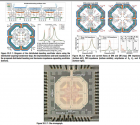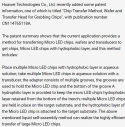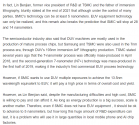You are using an out of date browser. It may not display this or other websites correctly.
You should upgrade or use an alternative browser.
You should upgrade or use an alternative browser.
Chinese semiconductor industry
- Thread starter Hendrik_2000
- Start date
- Status
- Not open for further replies.
Ok so this 7nm chip has been out since July 2021 but we are suddenly getting all these mainstream reports about it now, right before a major political push in the US Congress for the CHIPS Act and as there is bureaucratic tussling in the Biden administration for more sanctions on Chinese chipmakers. It seems clear this is all a part of a lobbying push on the part of techno-nationalist US forces to buff up the perception of Chinese capabilities in order to win political battles at home. It may result in more sanctions against China.
Or maybe they didn’t notice because it wasn’t advertised.
Hendrik_2000
Lieutenant General
It is too late because the horse has left the barn already. The main thing is they get the process working does not matter if it mining operation or not . Go ahead put more sanction and China just can give Holland the Lithuania treatment. No it has nothing to do with conspiracy to levy embargo. I though you are the one who is very skeptical of Chinese capability now you change your tune and make it as if this ruse created by China hawk!Ok so this 7nm chip has been out since July 2021 but we are suddenly getting all these mainstream reports about it now, right before a major political push in the US Congress for the CHIPS Act and as there is bureaucratic tussling in the Biden administration for more sanctions on Chinese chipmakers. It seems clear this is all a part of a lobbying push on the part of techno-nationalist US forces to buff up the perception of Chinese capabilities in order to win political battles at home. It may result in more sanctions against China.
manqiangrexue
Brigadier
LOLOLOL Didn't you just accuse other people of believing in China's achievements when they're not published?Ok so this 7nm chip has been out since July 2021 but we are suddenly getting all these mainstream reports about it now, right before a major political push in the US Congress for the CHIPS Act and as there is bureaucratic tussling in the Biden administration for more sanctions on Chinese chipmakers. It seems clear this is all a part of a lobbying push on the part of techno-nationalist US forces to buff up the perception of Chinese capabilities in order to win political battles at home. It may result in more sanctions against China.
Chinese semiconductor industry
Ignore him. He's falling back to the classic western trope of taking a little molehill and making a mountain out of it. The thing is there isn't even a molehill! People assume there's a molehill (domestic ArFi scanners aren't ready) because there haven't been any announcements. There aren't...
www.sinodefenceforum.com
Before we celebrate too much at what is indeed a major breakthrough, do keep in mind that bitcoin mining machines don’t have the same requirement as consumer electronics like phones and tablets. At least as of last year it appears that SMIC is using MinerVa as a practice dummy for improving their 7nm recipe.
The significance is twofold IMHO.
1. The Chinese fab a chip that is better than anything the Americans can do.
2. IC inside China expands ruthlessly all the way just one node behind the cutting edge.
3. All this was done under US sanctions, which kind of shows how useless US sanctions really are when it comes to China.
Points 1 and 3 will really rankled those nitwits in Washington DC, if they actually knew what this is all about.
Going forward, it is all about replacing foreign technology (assuming they do not play nice), and it is all about adding capacity.
This will be a slow process.
What does not seem to be a problem, is the know-how.
Let's not be polite here. At 7nm, the Chinese have the same or better know-how on how to make such as chip compared to the Americans. Bitcoin mining is kind of complicated, this is no ordinary chip.
The systems integration for a 7nm chip, the know-how at all points in the system is the key. Now China is just one node away from the cutting edge.
Demonstration of the know-how is the key point, a whole year or two ago, and the political in-your-face message is very important.
What is the point of banning ASML machines to China? Or South Korea joining some chip-pack?
How vicious do they want this fight to be with China?
========== ============
What hurt SMIC here, probably was the EDA, as the most advanced design tools were American and not available to them, according to the stories we are told.
My impression is that with this problem, those Chinese guys will come back from America, bringing the know-how, and that will alleviate much of that problem.
Unless Huawei beats them to it.
How vicious do they want this fight to be with China?
========== ============
This is what happened.
China gave Airbus and gigantic order, and Boeing got nothing.
Two or three weeks later, this news still cracks me up, haha! Haha!
Kind of odd, since China actually signed a deal with America to buy a lot of stuff.
Oh well.
3.Damn, ACM is on fire. If they can expand into etch products like speculated that would mean China has 2 etch suppliers - both AMEC and ACM.
Each of them are in distinct segment of semiconductor etching equipments.
ACM - Wet etch
Zhongwei/AMEC - ICP plasma etch (5nm process capability)
Huachuang/Naura - CCP metal & silicon etch (7nm-10nm verification phase)
Good catch..did not notice ACM was wet etch. That is totally different from dry etch. It seems that ACM is 100% wet chemistry. So they should be picking up the electrodeposition business soon if not already.3.
Each of them are in distinct segment of semiconductor etching equipments.
ACM - Wet etch
Zhongwei/AMEC - ICP plasma etch (5nm process capability)
Huachuang/Naura - CCP metal & silicon etch (7nm-10nm verification phase)
20.2 A 3.09-to-4.04GHz Distributed-Boosting and Harmonic-Impedance-Expanding Multi-Core Oscillator with-138.9dBc/Hz at 1MHz Offset and 195.1dBc/Hz FoM
In recent years, the rapid development of 5G wireless communication technology and Internet of Things technology in the application side, as well as the breakthrough of artificial intelligence technology in intelligent sensing, identification technology and other communication sensing technologies have laid the foundation for the intelligent era of the Internet of Everything. Therefore, the Internet of Everything is called It is the third wave of the development of the world information industry after the computer and the Internet. Under this trend, in order to support the construction of wireless transmission networks with larger scale and more connected devices, chip products need to have more powerful and stable performance.Multi-frequency and multi-standard wireless transmission systems are one of the keys to building the Internet. Broadband signal generation arrays are widely used. This type of architecture faces problems such as mutual interference between sub-frequency sources and mutual coupling between oscillators, which affect the output signal. Quality, spectral purity, frequency coverage; at the same time, the multi-core architecture will lead to a bloated system and high overall power consumption. Therefore, how to achieve low phase noise , high figure-of-merit (FoM, figure-of-merit) broadband signal generation and establish related design theories and methods has become a major challenge for the new generation of wireless transmission.
The high-energy-efficiency and high-speed wireless transmission system is the carrier that ultimately realizes intelligence through the interconnection of all things. The existing transmission system focuses on improving the peak efficiency of the system, but for complex modulated signals, the overall efficiency of the traditional transmission system is not high. Therefore, how to improve the overall system efficiency and transmission data rate of the single transmission system has become the key to the research of the new generation transmission system.
In response to the above problems, Professor Luo Xun's team established discrete coupling and harmonic impedance expansion theory and a design method to reduce DC power consumption based on floating capacitors. Research on power digitized quadrature power amplifier, the results of which are respectively "A 3.09-to-4.04GHz distributed-boosting and harmonic-impedance-expanding multi-core oscillator with -138.9dBc/Hz at 1MHz offset and 195.1dBc/Hz FoM" (hereinafter referred to as "result 1") and "A watt-level quadrature switched/floated-capacitor power amplifier with back-off efficiency enhancement in complex domain using reconfigurable self-coupling canceling transformer" (hereinafter referred to as "result 2") were published under the title In ISSCC 2021, the first author of the first paper is Shu Yiyang , and the corresponding author is Professor Luo Xun ; the first author of the second paper is Yang Bingzheng , and the corresponding authors are Associate Professor Qian Huizhen and Professor Luo Xun.

- Status
- Not open for further replies.


